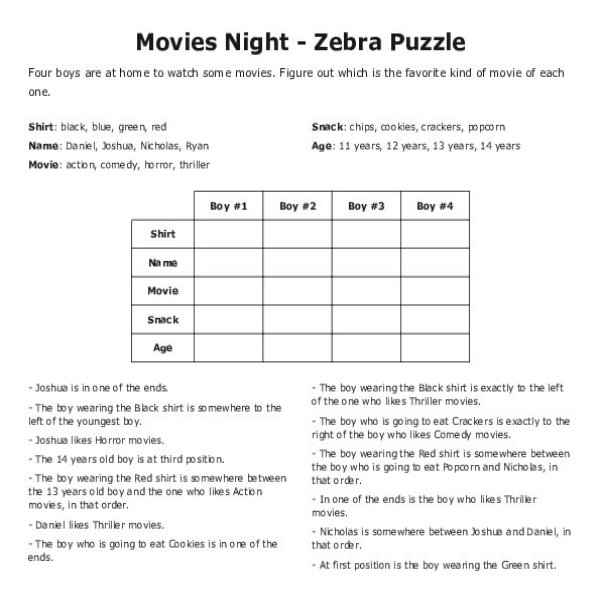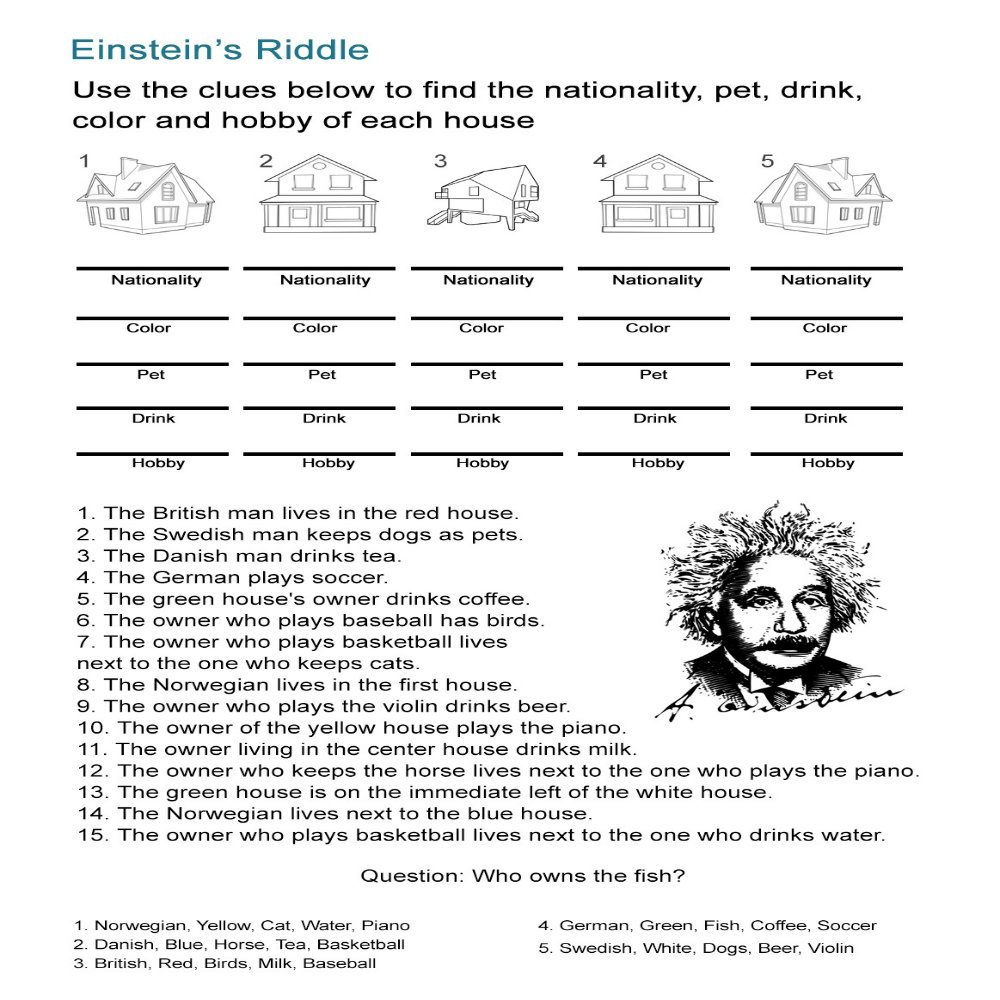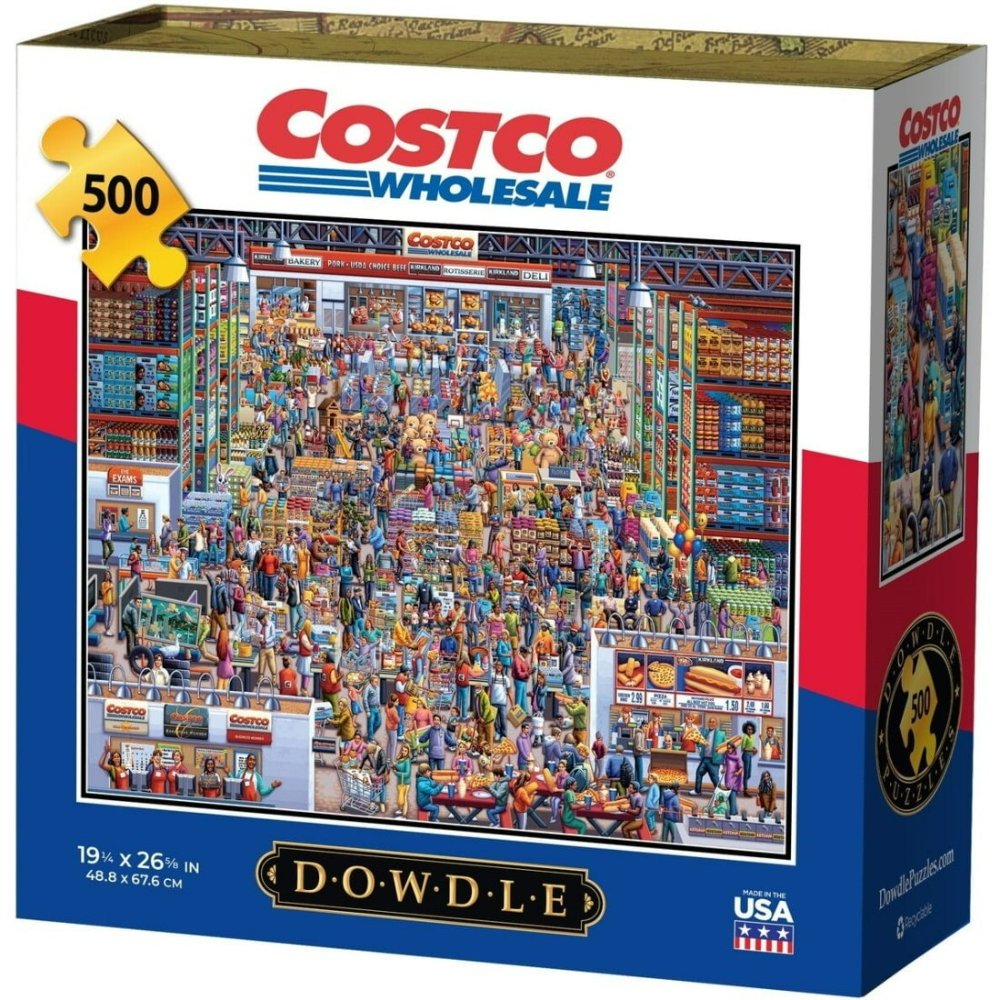Introduction to Zebra Puzzles
Zebra puzzles, also known as logic puzzles, challenge the mind in unique ways. They require deductive reasoning and sharp attention to detail. Each puzzle presents a set of clues. These clues relate various pieces of information to each other. The goal is to match all given items correctly.
The name ‘zebra puzzle’ stems from a classic version. This version has participants deduce the owner of a zebra. Since its inception, the term now covers a broad range of puzzles. Each puzzle has its own theme and set of items to match.
People of all ages find these puzzles engaging and brain-stretching. They offer a fun way to improve logical thinking and problem-solving skills. Whether you are new or experienced, there is always a zebra puzzle to challenge you.
In this guide, we will explore key components of zebra puzzles. We will discuss how they work and why they captivate so many enthusiasts. Let’s dive into the world of zebra puzzles and enhance our puzzle-solving expertise.

Key Components of Zebra Puzzles
Understanding the key components is crucial when tackling zebra puzzles. These puzzles have distinct parts that, when understood, make solving them much easier. Let’s break down these components:
- Variables: These are the different categories you need to match. Often, they include people, colors, pets, and drinks, among others.
- Clues: The puzzles provide a set of statements. Each one hints at the relationships between variables. Read these carefully; they are your road map to the solution.
- Grid: A grid is a tool to organize information. Use it to mark off relationships that are true and eliminate ones that are not.
- Deduction: This is the logical process of inferring relationships from known facts. You’ll use it to connect the dots between clues.
- Patience: Zebra puzzles require time and concentration. Don’t rush. Pay attention to each detail.
- Perseverance: Some puzzles can be intricate. Keep at it, even if the solution doesn’t come immediately.
Each component plays a vital role in solving zebra puzzles. Variables set the stage, clues direct your reasoning, and the grid helps track your progress. Deduction is your primary tool, while patience and perseverance are your allies. Keep these components in mind, and you’ll be on your way to mastering zebra puzzles.
Step-by-Step Guide to Solving Zebra Puzzles
Solving zebra puzzles can be a rewarding mental exercise. Here’s a structured approach to tackle them effectively:
- Gather Your Tools: Before you start, ensure you have a pencil, eraser, and a grid for tracking progress.
- Read the Clues Thoroughly: Go through each clue carefully. Understanding is key to solving zebra puzzles.
- Start with the Simplest Clues: Identify direct relationships first. These can give quick wins and structure.
- Mark the Grid: Use the grid to line up categories. Record findings and rule out impossibilities.
- Look for Keywords: Words like ‘beside’, ‘not’, and ‘directly’ offer vital hints.
- Utilize Process of Elimination: The process can refine possible matches and simplify choices.
- Check Off Solved Variables: As you solve parts of the puzzle, check them off to avoid confusion.
- Revisit Tougher Clues: After initial passes, go back to solve harder clues with fresh eyes.
- Stay Organized: Keep your grid and notes tidy. This prevents mistakes and aids thinking.
- Take Breaks as Needed: Sometimes stepping away can refresh your perspective and help you solve difficult parts.
By following these steps and using logical deduction, you will enhance your zebra puzzles solving skills. Keep practicing and soon, you’ll tackle even the most challenging puzzles with ease.

Common Challenges and How to Overcome Them
When solving zebra puzzles, puzzlers may face several common challenges. Here’s how you can overcome them to continue enjoying the puzzle-solving journey:
- Overwhelming Information: Sometimes the sheer amount of data seems too much. Focus on one category at a time to simplify the puzzle.
- Conflicting Clues: You might think clues contradict each other. Re-read them and make sure you’ve not misunderstood the relationships.
- Grid Confusion: Keeping track of multiple variables can be tricky. Use different colors or symbols to distinguish between categories on your grid.
- Losing Patience: It’s easy to get frustrated when answers don’t come quickly. Remember that patience is a key component. Take breaks if necessary.
- Hitting a Dead-End: If you feel stuck, review what you’ve marked as true and false. Sometimes you may need to reassess earlier decisions.
- Distractions: External noises and interruptions can disrupt your thought process. Try to solve puzzles in a quiet place where you can concentrate fully.
By anticipating these challenges and applying these strategies, you’ll navigate through the complex waters of zebra puzzles more smoothly. Remember, practice is crucial. The more puzzles you solve, the better you’ll become at overcoming these hurdles.
Advanced Techniques for Solving Zebra Puzzles
To master zebra puzzles, you need a strong strategy. Here are some advanced techniques:
- Work Backwards: Sometimes starting from the end can help. If a clue says ‘The one who owns the zebra lives in the last house’, begin there.
- Make Educated Guesses: If you’re stuck, make a guess based on the most evidence. Then see if other clues line up with this guess.
- Use Indirect Clues: Clues that seem unrelated can offer insight. Use them to make connections between other variables.
- Pattern Recognition: Notice patterns in the clues. They can guide your thinking and help you predict relationships.
- Chunking Information: Group related clues together to manage them better. This can simplify complex puzzles.
- Check Your Work Often: Regularly ensure your deductions make sense. This prevents you from moving on with mistakes.
When using advanced techniques in zebra puzzles, remember to stay focused and flexible. With these strategies, you’re equipped to tackle even the most daunting zebra puzzles. Keep practicing and refining your approach as you go.

Practice Puzzles and Solutions
To master zebra puzzles, practice is key. Here, we offer some practice puzzles and solutions to help sharpen your skills. These examples will enhance your ability to solve zebra puzzles efficiently.
- Beginner Puzzle: Start with a basic puzzle. It involves fewer variables and simpler clues. Once solved, review the step-by-step solution to understand the logic behind each decision.
- Intermediate Puzzle: Increase the complexity slightly. This puzzle introduces more variables and a few trickier clues. Solutions provided will help you grasp more advanced deduction techniques.
- Advanced Puzzle: For those ready to test their skills, tackle this challenging puzzle. It includes indirect and nuanced clues. Analyzing the provided solution can greatly enhance your understanding of complex zebra puzzles.
Each solution breaks down the reasoning and strategies used. This method not only helps in solving the particular puzzle but also provides insights into tackling similar puzzles in the future. Practice these regularly to improve your zebra puzzle-solving prowess.
Tips from Experts
Learning from those who have mastered zebra puzzles can greatly enhance your puzzle-solving abilities. Here are expert tips to refine your strategy and approach:
- Break Down the Clues: Experts suggest analyzing each clue individually before trying to see the bigger picture. Simplify and solve step-by-step.
- Stay Disciplined with the Grid: Consistent use of the grid is essential. Cross-reference everything to prevent mistakes and oversight.
- Recognize False Leads: Some clues are designed to mislead. Look out for these and don’t get sidetracked by assumptions.
- Develop a Routine: Establish a solving routine. This can help maintain focus and reduce errors caused by jumping around clues.
- Trust Logic, Not Instinct: While instincts can be helpful, relying solely on them can misguide. Stick to logical deduction for accurate solutions.
- Practice Extensively: There’s no substitute for practice. The more you solve zebra puzzles, the more patterns you’ll recognize and the quicker you’ll become.
By incorporating these expert tips, your efficiency and success rate in solving zebra puzzles will see significant improvement. Practice these strategies, and over time, you’ll notice your ability to solve even the most complex zebra puzzles develop beautifully.
Tools and Resources for Enhancing Puzzle Solving Skills
To excel in solving zebra puzzles, you need the right tools and resources. Here are some essentials to assist you:
- Puzzle Books: Choose books specifically designed for zebra puzzles. They provide a range of difficulties.
- Online Forums: Join forums where puzzle enthusiasts share tips and solutions.
- Puzzle Apps: Download apps tailored for zebra puzzles. They offer interactive experiences.
- Logic Puzzle Grids: Use online grids or templates. They help keep track of your deductions.
- Tutorials and Guides: Look for online tutorials. They explain puzzle strategies in detail.
- Workshops and Webinars: Attend sessions hosted by puzzle experts. Gain insights into advanced solving techniques.
Using these tools and resources, you can sharpen your puzzle-solving skills effectively.


